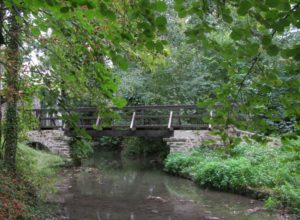R436 – Le pont de Maincy 1879-1880 (FWN143)
Pavel Machotka
(Cliquer sur l’image pour l’agrandir)
Perhaps no use of the parallel touch is more satisfying during its early years than when it integrates a mass of enveloping foliage with a simple masonry framework, as it does in Le pont de Maincy. I confess to a particular closeness to this painting, and have written about it already, but in the present context the achievements of its touch seem all the more clear. Thanks to a photograph, we know the givens that Cézanne worked with: a nearly symmetrical composition, an opposition between dark greens and warm pinks, some vertical tree trunks, and an unruly profusion of leaves. It is a lovely site—on the outskirts of Melun, at Trois Moulins, and therefore dated easily—and yet when photographed it makes no more than a happy postcard; the painting, on the other hand, joins everything together in a resonant unity. It not only aligns the scraggly branches with the bridge supports, but it groups the parallel notations for the leaves—with particular care in the upper center—in a way that makes them, too, participate in the picture’s rhythms.
That some of the touches should be literal and others abstract seems inevitable here; this is a site that requires the interplay of the actual and the arranged. Cézanne, in fact, devotes even more thought to the space in the picture than to the leaves. Having painted the bridge parallel to the picture plane—more parallel than it appeared from where he stood—but needing to push the left supporting arch further back, he must use the tree to divide the bridge; now part of it can be in the picture plane and another part can recede, and the painting becomes both a flat physical object and a scene in real space.
Adapted from Pavel Machotka, Cézanne: The Eye and the Mind.
Le pont a servi de motif à d’autres peintres, comme Charles Georget (école de Barbizon) qui le représente à la même période que Cezanne :





